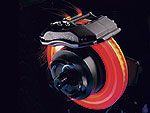
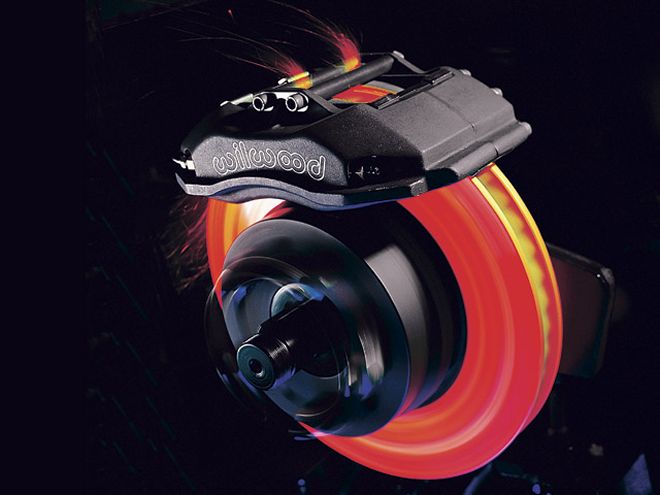
Going faster is something we all aspire to. It is part of the genetic makeup of the car enthusiast to crave more and more horsepower in a never-ending quest to be faster. But, is being faster just a matter of making more horsepower? The answer is not just no, but a resounding, hell no!
So how can one be faster without adding more ponies to the engine? One way is to make your car lighter. Having a higher power-to-weight ratio will make your car faster. Another often-overlooked way for a car to get around the track faster is to have the right braking system. Having higher-performance brakes will allow you to drive deeper into the corners before having to brake. Carrying your speed longer will result in faster lap times and can often be the edge you need over cars that have more horsepower. Having the right binders will also save your bacon when things go wonky. There's also a certain amount of confidence imbued to the driver when he knows he can depend on his brakes to do their thing lap after lap. Being worried that your brakes will fail you when needed will cause you to brake early, so you won't push your car, resulting in slower laps.Even if your car will never see the apex of a professional track, good brakes just make street driving more fun. These days, getting cutoff is a daily occurrence, so we know that properly functioning brakes are a necessity. It is very comforting to know you can stop faster than the guy in front of you; just watch out for those tailgaters.
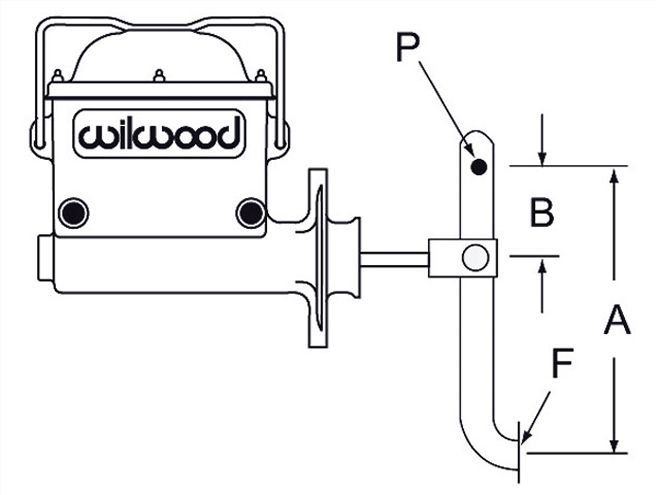 Pedal ratio, or mechanical leverage, is the ratio calculated from the length from the pivot point of the pedal to the center of the brake pedal (A), divided by the length from the pivot point to the master cylinder pushrod (B). Mechanical leverage is simply a means of increasing the brake force without increasing your leg effort. As "A" gets longer and "B" gets shorter, the mechanical leverage increases brake force without pushing harder on the pedal. The disadvantage is that the pedal stroke also increases, requiring you to push the pedal further. "P" represents the pivot point and "F" is the force, or push. With a 1-inch master cylinder stroke, a 100-pound push on the pedal, and the pedal having a 4:1 ratio, the force is 4 x 100, or 400 pounds, and the stroke is 4 x 1, or 4 inches. If you are not sure what ratio is best for your application, then a 6:1 ratio is a great starting point.
Pedal ratio, or mechanical leverage, is the ratio calculated from the length from the pivot point of the pedal to the center of the brake pedal (A), divided by the length from the pivot point to the master cylinder pushrod (B). Mechanical leverage is simply a means of increasing the brake force without increasing your leg effort. As "A" gets longer and "B" gets shorter, the mechanical leverage increases brake force without pushing harder on the pedal. The disadvantage is that the pedal stroke also increases, requiring you to push the pedal further. "P" represents the pivot point and "F" is the force, or push. With a 1-inch master cylinder stroke, a 100-pound push on the pedal, and the pedal having a 4:1 ratio, the force is 4 x 100, or 400 pounds, and the stroke is 4 x 1, or 4 inches. If you are not sure what ratio is best for your application, then a 6:1 ratio is a great starting point.
So how does one wade though the minutia to pick a brake system that is right for a particular application? With so many terms and offerings there is a lot of confusion and the result is that people either buy the wrong system to fit their needs or worse, they end up with mismatched parts and a poorly functioning system. In an effort to explain how braking systems work, we went to the crew at Wilwood Engineering. Wilwood Engineering been doing this for a long time and is also one of the few braking companies that offer complete solutions. In other words, Wilwood sells and develop severything from the pedal to the pad, and all the parts in between.
Pedal Effort
When you push on the brake pedal, how is your effort translated into braking power? Many factors effect how hard you have to push on the brake pedal to get a certain amount of stopping power. The first is the leverage ratio of the brake arm. This leverage translates the effort of your leg into braking force. As you can see in the diagram, varying the ratio of the stroke can greatly change the amount of power translated into your master cylinder.
One of the biggest decisions you will be faced with is whether you should run manual or power-assisted brakes on your car. Some people like the more mechanical feel of manual brakes, while others want the lighter effort required by a power-assist unit.
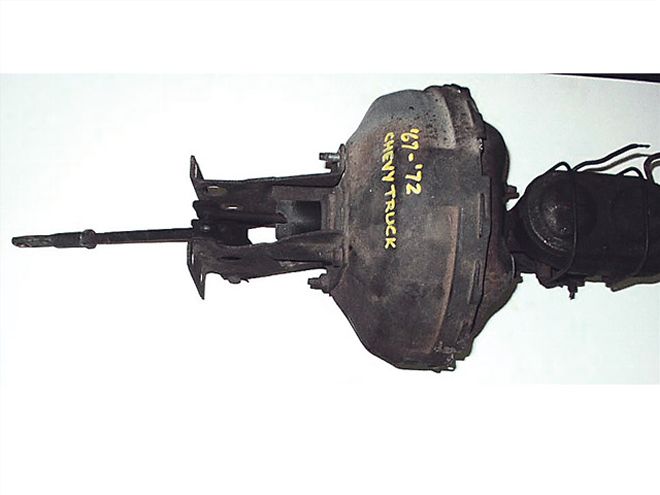 On cars with a vacuum booster, the brake pedal pushes a rod that passes through the booster into the master cylinder, actuating the master-cylinder piston. The engine creates a partial vacuum inside the vacuum booster on both sides of the diaphragm. When you hit the brake pedal the rod cracks open a valve, allowing air to enter the booster on one side of the diaphragm while sealing off the vacuum. This increases pressure on that side of the diaphragm so that it helps to push the rod, which in turn pushes the piston in the master cylinder. Simple, effective, and cheap are the three traits that have made it so prolific on factory cars. The downsides are size, and that it is dependent on engine vacuum.
On cars with a vacuum booster, the brake pedal pushes a rod that passes through the booster into the master cylinder, actuating the master-cylinder piston. The engine creates a partial vacuum inside the vacuum booster on both sides of the diaphragm. When you hit the brake pedal the rod cracks open a valve, allowing air to enter the booster on one side of the diaphragm while sealing off the vacuum. This increases pressure on that side of the diaphragm so that it helps to push the rod, which in turn pushes the piston in the master cylinder. Simple, effective, and cheap are the three traits that have made it so prolific on factory cars. The downsides are size, and that it is dependent on engine vacuum.
We could do an entire story on vacuum-assisted power brakes, but let's just say that it uses engine-created vacuum to increase the amount of force exerted on the master cylinder. This causes you to not have to push as hard on the brake pedal to get the same effect in braking. The downside of this system is that your engine has to produce enough vacuum in order for this to work, and that is not always possible on high-performance engines that make good power and create very little vacuum. You also need room in your engine bay for the sometimes-large vacuum booster. Another way to get power-assisted brakes is through the use of a hydraboost-type system. This system uses your power-steering pump pressure to multiply the effect of your pedal effort by use of hydraulic pressure. The big plus is that it does not rely on engine vacuum and, although it does protrude from the firewall quite a bit, it does not take up much room side-to-side. This means it is less likely to get in the way of those tall big-block valve covers. It does tend to clutter up your engine bay, and if you loose your power-steering pump for whatever reason, you will also loose your power assist. Still, this type of system can really up the line pressure of your braking system.
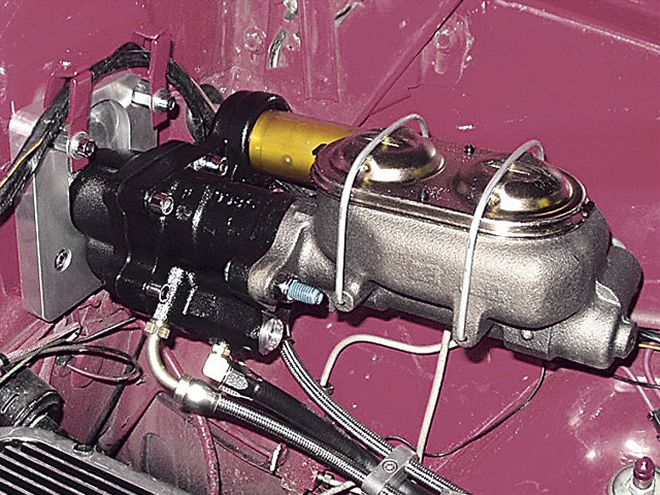 This hydroboost system is an excellent option for those who want power-assisted brakes, but for whatever reason, cannot run a traditional vacuum-assist unit. Plumbed into your power-steering system between your pump and your box/rack, this unit uses fluid pressure to help multiply your leg effort into increased pressure in the master cylinder. You can even see this system employed on quite a few OEM vehicles, such as the Hummer H2 and most new Cobra Mustangs.
This hydroboost system is an excellent option for those who want power-assisted brakes, but for whatever reason, cannot run a traditional vacuum-assist unit. Plumbed into your power-steering system between your pump and your box/rack, this unit uses fluid pressure to help multiply your leg effort into increased pressure in the master cylinder. You can even see this system employed on quite a few OEM vehicles, such as the Hummer H2 and most new Cobra Mustangs.
The Master Cylinder
So, you have the right pedal leverage and have decided that you want the assistance of a power unit. Now it is time to look at your master cylinder. Back in the olden days, these were simple one-reservoir units that left much to be desired in both performance and safety. Today, master cylinders are packed with high-tech engineering and can make or break your system. Almost all the master cylinders used today are tandem units. This refers to the fact that they have two internal reservoirs: one for the front and one for the rear brakes. One important factor in choosing the right master cylinder is the volume of fluid it holds. For a high-performance system you want to make sure the unit will hold enough fluid to service your needs. More fluid means cooler fluid temps and extra insurance for extreme conditions where high pad wear can compromise fluid levels during extended performance driving events. Remember that as your pads wear down the fluid level in your master will also go down. Generally speaking, you need a larger master cylinder for bigger multi-piston brake systems, and you can go with a smaller, more OEM-sized unit for smaller systems.
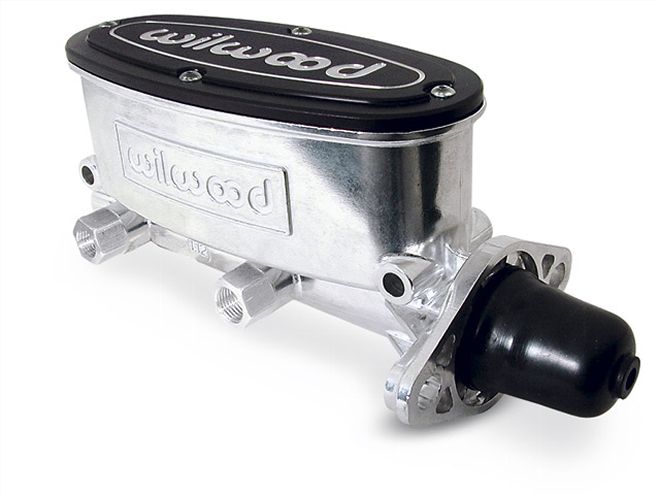 Here is Wilwood's latest tandem master cylinder. This master cylinder holds a good amount of fluid and looks pretty damn nice. When picking the right master cylinder for your ride, be sure to get one with the right bore size for your application.
Here is Wilwood's latest tandem master cylinder. This master cylinder holds a good amount of fluid and looks pretty damn nice. When picking the right master cylinder for your ride, be sure to get one with the right bore size for your application.
The most critical factor in master cylinder selection is bore size. Bore sizes can range from 5/8 inches upward to 1 1/8 inches or more. The bore size determines the amount of hydraulic pressure and fluid volume that will be sent downstream to the calipers. The actual amount of hydraulic pressure generated is based on the amount of force coming from the pedal or booster being divided by the area in square inches of the master cylinder bore. For example, a master cylinder with a 1-inch bore has .785 square inches or bore area. ( Bore x Bore x .785) If the pedal or booster delivers 500 pounds of force to the master cylinder, the hydraulic pressure will be equal to 500 divided by .785, which would result in 637 psi going to the lines. The displaced volume capacity is then based on the length of the available stroke multiplied by the bore area. It's the same formula that's used to calculate engine displacement for one cylinder.
Generally speaking, if the master cylinder bore is too large, the driver will feel a very hard pedal feel with minimal pedal travel, and will have a difficult time generating the necessary pressure to effectively operate the brake system. If the master cylinder bore size is too small, the driver will be able to generate a lot of pressure, but the pedal may have an excessively long stroke or a very spongy feel. And if the bore size is way too small, the pedal or master cylinder may bottom out before enough volume is pumped to operate the calipers. The best advice would be to consult with the manufacturer of the brake system you will be using and work with them to pick the right size for your application.
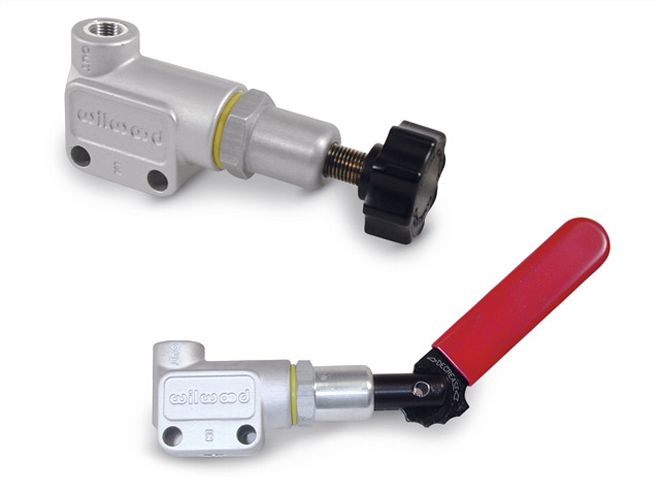 These are the two most common types of adjustable proportioning valves. The knob type is the most common on the street and the lever type is mostly seen in race cars. Both serve essentially the same function.
These are the two most common types of adjustable proportioning valves. The knob type is the most common on the street and the lever type is mostly seen in race cars. Both serve essentially the same function.
The Proportioning Valve
Now that you have line pressure, you need to control it. This is where an adjustable proportioning valve is used. Factory cars have a proportion valve installed, but it is not adjustable and is set at a good compromise for that particular car. A proportioning valve is used to limit line pressure to the brakes--generally the rear brakes. By adjusting the pressure to the brakes you are able to dial in the amount of stopping force the brakes have. The last thing you want are your rear brakes to lock up before your fronts, since this will cause you to see your life fly before your eyes as the back of your car tries to switch places with the front. By adjusting this valve through trial and error you can find the right bias between your front and rear brakes.
These valves are generally seen in two types: The first is the more common knob style. These valves are usually located outside the passenger's compartment and, in most cases, near the master cylinder. These are best adjusted when driving the car in a safe area. Rear line pressure is increased or decreased by turning the knob until you get the desired results. Once set, it is usually left alone. The other style is the lever type, and is more typically seen in race applications. Mounted near the driver, this type is dialed in to suit the track or even a particular part of the track.
Whatever type you get, they both do relatively the same thing--allow you to adjust your front-to-rear bias and provide for a maximum decrease of 57 percent in line pressure. If you need more than this, then chances are you have mismatched parts in your brake system.
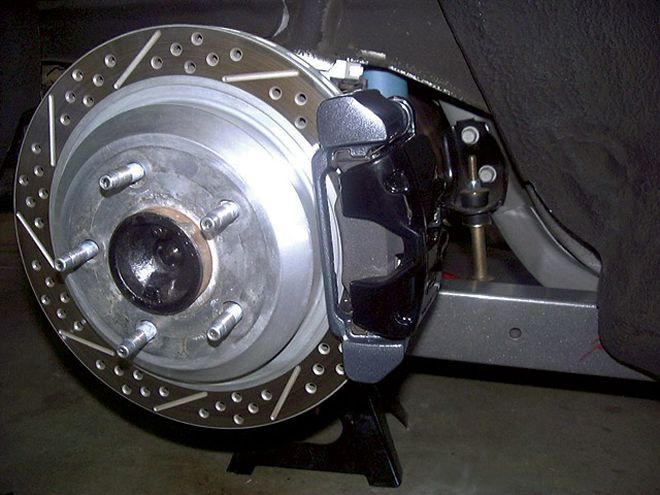 This is a typical floating caliper. Very common to OEM cars, this type of caliper is easy to maintain, cost-effective to make, and very forgiving. Modern Camaros, Mustangs, and Corvettes all use this type of caliper with good results. This is a single-piston unit on the back of a later F-body.
This is a typical floating caliper. Very common to OEM cars, this type of caliper is easy to maintain, cost-effective to make, and very forgiving. Modern Camaros, Mustangs, and Corvettes all use this type of caliper with good results. This is a single-piston unit on the back of a later F-body.
Calipers
The next stop for the brake fluid is the calipers. Calipers come in two types: Floating and fixed.
The first type--floating--is typically found on your average car from the factory. They are quiet, forgiving, and easy to maintain. A single or dual piston is located inboard of the disc, and the outer body of the caliper floats on a bracket. The piston forces the inboard pad against the disc while the sliding outer body clamps the outboard pad against the other side of the rotor. The inherent lack of rigidity in the design, compared to a fixed-caliper design, combined with the friction inherent in the sliding outer body, makes this design less suitable for racing and high-performance use. In all applications this caliper type is simpler to manufacture and affords more packaging flexibility for zero or even negative scrub radius front suspension designs. Often with this design you will see twin-piston front calipers and single-piston rear units. Fixed calipers are what Wilwood uses in all its systems, so that's what it recommends. In fairness to other manufacturers that offer floating calipers, a floating caliper can offer most of the performance of a fixed caliper at a fraction of the cost. The trade-off really comes into play only under race conditions, where flexure and the speed of pad replacement becomes an issue.This is typically found on your average car from the factory. They are quiet, forgiving, and easy to maintain. A single or dual piston is located inboard of the disc, and the outer body of the caliper floats on a bracket. The piston forces the inboard pad against the disc while the sliding outer body clamps the outboard pad against the other side of the rotor. The inherent lack of rigidity in the design, compared to a fixed-caliper design, combined with the friction inherent in the sliding outer body, makes this design less suitable for racing and high-performance use. In all applications this caliper type is simpler to the manufacturer's and affords more packaging flexibility for zero or even negative scrub radius front suspension designs. With this design you will often see twin-piston front calipers and single-piston rear units. Fixed calipers are what Wilwood uses in all its systems, so that's what it recommends. In fairness to other manufacturers that offer floating calipers, a floating caliper can offer most of the performance of a fixed caliper at a fraction of the cost. The trade-off really comes into play only under race conditions, where flexure and the speed of pad replacement becomes an issue.
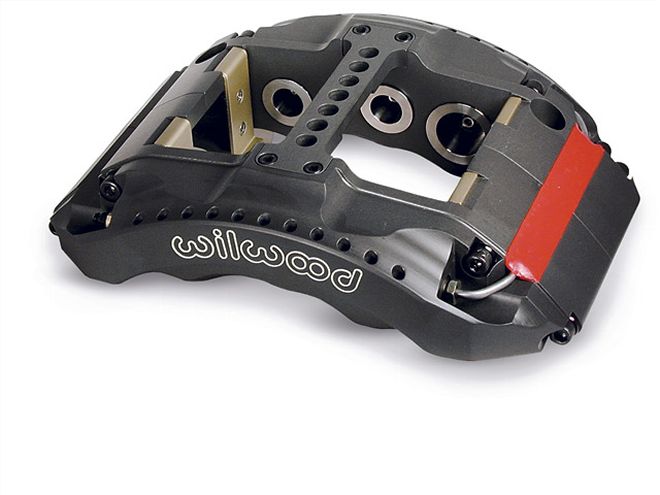 Fixed calipers are not found on your typical factory car due to their cost and the fact that they are less forgiving in the manufacturing process. Notice the use of different sized pistons. This is known as piston differential, and helps keep the pad flat against the rotor. You can also tell that this is a two-piece caliper since it has the crossover tube for the brake fluid. Two-piece calipers can be as strong or even stronger than mono-block calipers if designed properly. This unit is Wilwood's race-only STR caliper and is absolutely huge at over 8 inches wide and 11 inches long.
Fixed calipers are not found on your typical factory car due to their cost and the fact that they are less forgiving in the manufacturing process. Notice the use of different sized pistons. This is known as piston differential, and helps keep the pad flat against the rotor. You can also tell that this is a two-piece caliper since it has the crossover tube for the brake fluid. Two-piece calipers can be as strong or even stronger than mono-block calipers if designed properly. This unit is Wilwood's race-only STR caliper and is absolutely huge at over 8 inches wide and 11 inches long.
A fixed caliper is generally seen in more high-performance applications and offers higher clamping force and more even pad pressure. In this application the caliper is "fixed" to a rigid bracket or directly to the spindle. The fixed caliper is one in which two or more pistons are arranged on both sides of a rigid body with the disc sandwiched in the center. Due to its inherent stiffness, the fixed caliper is more efficient and translates more pressure to the pads. However, its increased size, cost, and weight prevents its widespread use on passenger vehicles.
Calipers are offered in a choice of number of pistons, piston size, method of construction, and what materials they are made from. Combined piston area, not caliper size, is the primary influence on a caliper's clamping power. The piston volume must match the master cylinder bore size and pedal leverage to realize peak performance from the system.
Piston material is selected based on the caliper's intended operating environment. Stainless steel pistons are used most often in calipers intended for high-performance or competition applications. Stainless steel is selected for its low heat transfer properties and high resistance to corrosion. Wilwood also offers multi-piece insulated Thermlock pistons that provide even more protection against heat transfer from the brake pads into the caliper body, piston seals and brake fluid. The other more common type of piston is made from aluminum, and these are used in low- to medium-temperature applications, usually in conjunction with rubber piston boots that protect the pistons from corrosion and debris.
Many fixed calipers have different sized pistons incorporated into the design. This "piston differential" helps push the pad flat against the rotor and keeps the pad from wearing faster on the leading edge. The pistons toward the leading edge of the pad will be smaller than the ones at the back edge of the pad. In regards to fixed calipers, there are also mono-block and two-piece calipers. Mono-block calipers are made from a single piece of billet, cast, or forged material. They are generally the most expensive, but not always the most rigid. A two-piece caliper is manufactured from two basically mirror imaged parts rigidly bolted together. To perform as well as a mono-block caliper the assembly must result in a rigid structure by design, bolt selection, and materials. A two-piece caliper is easy to identify since there will be a crossover tube visible on the outside of the housing.
Lastly, we come to dust boots. Dust boots are rubber seals that keep road grime from getting between the caliper bore and piston. They are found on all production car brakes and many aftermarket calipers. The real downside in high-performance and racing applications is that they tend to melt and deform when subjected to the high temps of heavy braking. High-performance brakes generally forego the rubber boot and instead rely on very tight tolerances and high-temp O-rings to keep debris and water from getting places they don't belong.
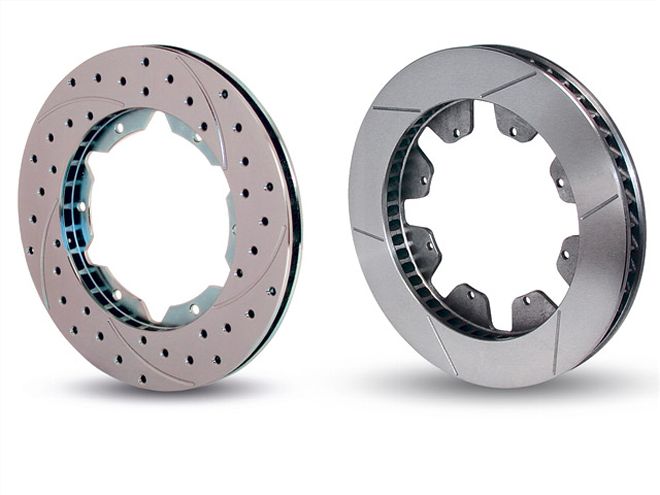 The rotor on the left is a zinc-plated slotted and drilled rotor. This should serve most people who want to look great and hit the track occasionally. Notice that the holes are all chamfered to help lessen the chance of cracking. For serious track time, you might be better off with the second rotor. It is a no-bling offering that can stand up to the massive stresses of heavy track time. The asymmetrical slot pattern helps provide smoother engagement through reduced harmonics. The grooves also help keep brake dust from building between the pad and the rotor face.
The rotor on the left is a zinc-plated slotted and drilled rotor. This should serve most people who want to look great and hit the track occasionally. Notice that the holes are all chamfered to help lessen the chance of cracking. For serious track time, you might be better off with the second rotor. It is a no-bling offering that can stand up to the massive stresses of heavy track time. The asymmetrical slot pattern helps provide smoother engagement through reduced harmonics. The grooves also help keep brake dust from building between the pad and the rotor face.
Rotors
Rotors are all about mass and heat dissipation. Think of the rotor as the radiator of the brake system. During braking, huge amounts of heat are generated by the action of slowing the car. This heat needs to be shed as quickly as possible to keep from cooking the brakes, which can lead to fade, or worse, failure. The more metal in a rotor, the more it takes to get them overheated. The venting design of the rotor's fins helps circulate air through the rotor and shed this heat. Also, we all see big rotors and think they look really great filling up that wheel, but there is an added benefit to large rotors. A larger rotor will have more mass for better heat control and the larger diameter will allow more leverage for the caliper. There is a point of diminishing return since as the rotor gets bigger it also gets heavier; lots of rotating mass robs acceleration and hinders stopping. Like all things in life, a happy medium needs to be kept.
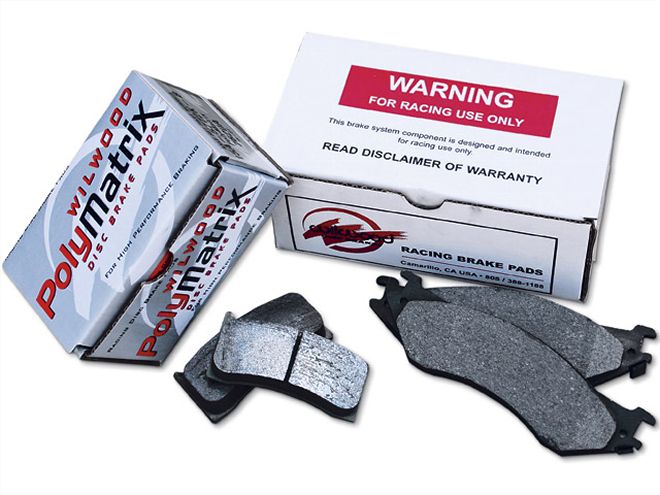 Another place where there are a wide array of choices is in the brake pads. For the street you need to find a pad that is a happy medium between performance and street manners....
Another place where there are a wide array of choices is in the brake pads. For the street you need to find a pad that is a happy medium between performance and street manners....
One thing we see debated all the time is the concept of drilled rotors. Back in the day, brake pads generated quite a bit of out-gassing during heavy use, and the holes would help keep this gas from interfering with the pad-to-rotor contact. Modern pad technology has pretty much gotten rid of these gases, so why are the holes still there? The simple answer is that they look really cool. But, this bitchin' look comes at a price. If not done right, the holes are a recipe for cracking when subject to heavy use. Under hard driving, every hole can become a new place for a crack to form. If done correctly, the chance for cracks are dramatically minimized, even under hard driving conditions, but the possibility is still there. For a street car that occasionally sees open-track days, there is no problem in using a properly engineered drilled rotor. You want to make sure the rotor was designed to be drilled, was drilled correctly, and that the holes have been at least chamfered to minimize stress and wear. If you plan on hitting the track a lot and really punishing your brakes, then you will be better served to forego the holes and run a solid rotor. Besides cracking, rotors are also subject to heat-checking, which is the precursor to cracking. Heat checks are very small cracks on the surface of the rotor caused by thermal stress. While they are not a cause for concern (yet), they do indicate that the disc is not getting adequate cooling and are a warning sign that cracks may follow.
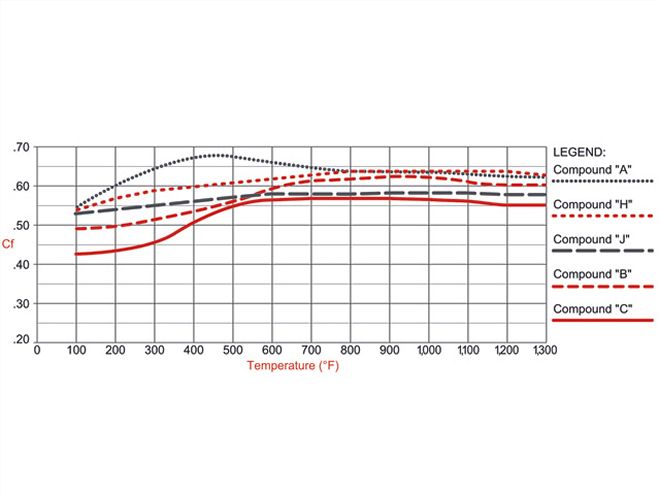 ...Race pads will stop your car better, but will inflict a lot of noise and dust into your daily commute. Street pads can't take the high temps of racing, but are quiet, low-dust, and operate well at lower temps. In this chart from Wilwood you can see how the various pad compounds perform as the temperature goes up...
...Race pads will stop your car better, but will inflict a lot of noise and dust into your daily commute. Street pads can't take the high temps of racing, but are quiet, low-dust, and operate well at lower temps. In this chart from Wilwood you can see how the various pad compounds perform as the temperature goes up...
The other most common addition to rotors is slots. Actually, they are more like grooves than slots. These don't actually weaken the rotor, and their purpose is to keep the area between the pad and rotor free of brake dust. Many competition cars will run a slotted iron rotor, and it's not a bad idea for your ride, either. The slots also lower the weight a little bit, like the holes, but it is not by much and is only a happy byproduct of the process.
Lastly, we come down to coatings. Rotors are made of iron and, as you know, iron rusts. To combat this force of mother nature, rotors are often offered with a zinc coating. The entire rotor is coated to keep it looking pretty. The area swept by the pads is also coated, but after the initial burn-in, this area is scoured clean of the zinc so the pads can work properly. If you park your car for a while, you will notice this area might start to rust, but after a couple of miles of driving all will be looking good again. If looks are more important than performance, a zinc-washed rotor is fine. However, if max performance is the goal, a zinc-washed rotor can become warped under severe usage as the coating melts and redeposits unevenly on the rotor. Pads can also become loaded up with unwanted zinc media and alter the pad's coefficient of friction.
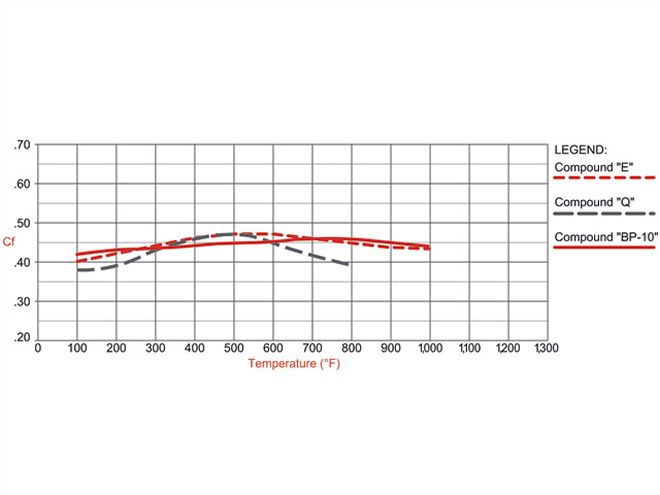 ...The pads in the top chart are their various track pads, the pads on the bottom are for the street. Notice how much better the race pads work when very hot compared the street pads.
...The pads in the top chart are their various track pads, the pads on the bottom are for the street. Notice how much better the race pads work when very hot compared the street pads.
Brake Pads
Pad selection is what really determines the personality of your brakes. Nowhere else is the concept of compromise more evident than here. On the street we want quiet brakes that generate a low amount of dust. On the track we want brakes that can stop on a dime time after time without fail. Unfortunately, it is very hard to have both. The best performing pads for the track are generally noisy and generate a lot of dust. Ironically, they also have pretty poor stopping power when used at typically lower street temperatures. The best pads for the street are quiet and clean, but have a lower tolerance for high heat and are prone to fading on the track. Many people have two sets of pads for their cars: a street set for cruising and a track set for tearing it up on track day. Wilwood has a new pad called BP-10. BP-10 is used to build its "smart pads." This new compound comes closer than ever to giving the best of both worlds. It really bridges the gap by offering track performance and street manners. Still, when it comes time to seriously hit the track, it is best to go to one of its high-performance Polymatrix pads.
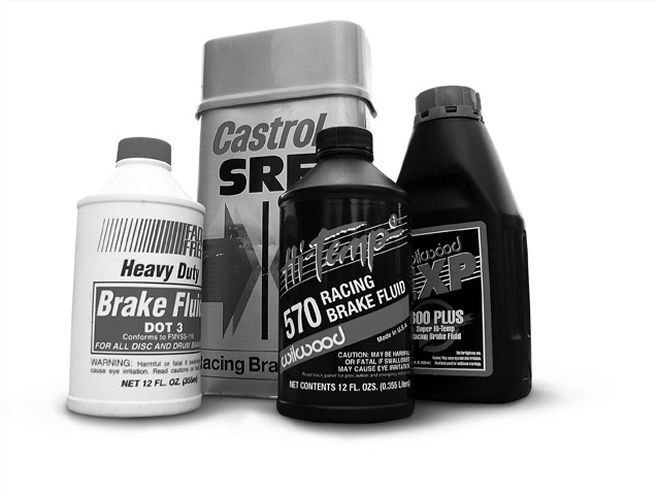 As they say, don't judge a book by its cover. This is especially true of brake fluid, which is offered in a huge array of prices and packaging. For your average street car, the cheapo stuff on the left will do you fine and will only set you back three or four bucks. For high-performance driving, you need to step up to a fluid that is going to hold up to the punishment. It may seem tempting, but don't skimp on what you buy; it is money well spent. Many companies make performance brake fluid, and you want one that can take the heat. Also, small bottles are better since fluid, once opened and exposed to air, starts to absorb water and become less effective. Keep in mind that fluid should be changed at regular intervals--even more often if you are hitting the track.
As they say, don't judge a book by its cover. This is especially true of brake fluid, which is offered in a huge array of prices and packaging. For your average street car, the cheapo stuff on the left will do you fine and will only set you back three or four bucks. For high-performance driving, you need to step up to a fluid that is going to hold up to the punishment. It may seem tempting, but don't skimp on what you buy; it is money well spent. Many companies make performance brake fluid, and you want one that can take the heat. Also, small bottles are better since fluid, once opened and exposed to air, starts to absorb water and become less effective. Keep in mind that fluid should be changed at regular intervals--even more often if you are hitting the track.
Fluid Dynamics
The one thing these systems have in common is that they all revolve around moving brake fluid. This is the life blood of your braking system, and even the best system with the wrong or bad fluid will not get the job done. The government (DOT) sets minimum standards for how brake fluids must perform. These standards are great for a street car or mini-van, but high-performance driving means high-performance stopping, and this can overtax your run-of-the-mill brake fluid.
There are also silicone-based fluids that are less hydroscopic than ether-based fluids, but they are subject to "frothing" when forced through small orifices or subjected to high-frequency vibration. This makes them more compressible and thus less suited for high-performance or racing use.
The main difference between standard and high-performance brake fluids is how it handles heat. For example, Wilwood's EXP 600 Plus has been tested to over 626 degrees F with a wet boiling point of 417 degrees. At these temps, your average fluid would be boiling away. It also has a low moisture affinity to slow the natural absorption rate of water vapor. As brake fluid absorbs water it becomes less effective, and the temp at which it boils goes down. This is why it is important to change your brake fluid on a regular basis and only use fresh fluid from sealed containers. The true test of any brake fluid is how well it resists aeration and compressibility after it has been heated and pressure-cycled a few hundred times.
The two main enemies of brake fluid are air and water. Water in your brake fluid will lower you effective boiling point and degrade your entire system's performance. If you have air in your brake lines, this will also degrade your system since the air will compress easier than the fluid would have, thus less energy is applied to the clamping force on the rotor. This is why it is important to keep fresh, high-quality fluid in your system and make sure all air is properly bled out.
Ironically, the effect of water in brake fluid is identical to the presence of air. As the water boils and turns to a vapor it becomes compressible, just like air. The danger in bleeding your brakes and not replacing all the fluid is that it's tempting to think that fade won't be an issue since the brakes have been bled of air. Another danger area is using new brake fluid out of an opened can. Brake fluid will begin picking up water the moment the can is opened--whether it's in your car or on the shelf in your garage. Never use an old, opened can of brake fluid--you might as well keep the old fluid already in your brake system.
Abrasive Friction: The mechanical rubbing of the brake pad material directly onto the rotor disc, resulting in the mechanical wear of both pad and rotor.
Adherent Friction: The transfer of a thin layer of brake pad material that sticks (adheres) to the rotor face. The layer of pad material, once evenly established on the rotor, is what rubs on the brake pad. The bonds that are broken for the conversion of kinetic to thermal energy are formed instantaneously before being broken again.
Bite: The speed at which the friction material reaches its maximum coefficient of friction when braking is initiated. The amount of bite is a compromise. Too much bite makes initial modulation difficult. Too little causes a delay in braking. In racing, different drivers prefer pads with different degrees of bite.
Brake bias: The term used to indicate the ratio between the amount of brake torque exerted on the front brakes compared with the rear. Brake bias is normally expressed as a percentage of brake torque at one end of the car to the total brake torque, as in "60 percent front."
Brake line pressure: The instantaneous hydraulic pressure within the brake lines. Brake line pressure in pounds per square inch is the force applied to the brake pedal in pounds multiplied by the mechanical pedal ratio (plus any booster assist where applicable) divided by the area of the master cylinder piston in square inches. For the same amount of pedal force, the smaller the master cylinder bore and/or the greater the mechanical pedal ratio and/or booster contribution, the greater the brake line pressure and the longer the pedal travel.
Braking torque: Braking torque in pounds-feet on a single wheel is the effective rotor radius in inches times clamping force in pounds times the coefficient of friction of the pad against the rotor (a unit-less value) all divided by 12. Braking torque is the force that actually decelerates the wheel and tire. To increase the braking torque it is necessary to increase the line pressure, the piston area (clamping force), the coefficient of friction, or the effective rotor radius. Increasing the pad area will not increase the braking torque.
Coefficient of friction: A dimensionless indication of the friction qualities of one material vs. another. A coefficient of 1.0 would be equal to 1g. The higher the coefficient, the greater the friction. Typical passenger car pad coefficients are in the neighborhood of 0.3 to 0.4. Racing pads are in the 0.5 to 0.6 range. With most pads the coefficient is temperature-sensitive, so claims that do not specify a temperature range should be viewed with some suspicion. The optimum is to select a pad with a virtually constant but decreasing coefficient over the expected operating range of temperatures. As a result, the driver does not have to wait for the pad to heat up before it bites, and the pad fade will not be a factor so that modulation will be easy.
Clamping force: The clamping force of a caliper in pounds is the brake line pressure multiplied by the total piston area of the caliper in a fixed caliper and two times the total piston area in a floating design. To increase the clamping force it is necessary to either increase the line pressure or the piston area. Increasing the pad area or the coefficient of friction will not increase clamping force.
Differential bores: The leading edge of a brake pad wears faster then the trailing edge. This is due to the migration of particles of incandescent friction material carried from the leading to trailing edge of the pad. In effect, the trailing portion of the pad is riding on a layer of incandescent material. By providing an optimally designed larger caliper piston at the trailing edge of the pad, wear can be evened along the length of the pad.
Effective temperature range: The range of operating temperatures within which a pad material remains effective or consistent. As with coefficient of friction, this should be used for comparative purposes only as measurement procedures vary between manufacturers and pad temperatures are strongly affected by disc mass and rate of cooling.
Friction consistency: The Thickness Variation (TV): Variation in the transfer layer that initiates brake vibration. While the impact of an uneven transfer layer is almost imperceptible at first, as the pad starts riding the high and low spots, more and more TV will be naturally generated until the vibration is much more evident. With prolonged exposure, the high spots can become hot spots and can actually change the metallurgy of the rotor in those areas, creating "hard" spots in the rotor face that are virtually impossible to remove.
Thermal shock: Disc materials, particularly cast iron, are degraded not only by the magnitude of temperatures reached, but also by the "delta" temperatures--the speed at which the temperature increases and decreases. Cracks are largely caused by weakening of the bonds between the grains of the metal brought about by rapid change in temperature.
Threshold braking: Braking at maximum possible retardation in a straight line.
Vanes: The term given to the central webs that serve to separate the inboard and outboard friction surfaces of ventilated discs. Beneficial for cooling if designed right. There are three types:
Straight vanes: Straight vanes are the easiest to manufacture. They extend in straight lines radially outward from the inner surface to the outer surface of the disc. This design is often used in production automobiles and trucks because the same part can be used on both sides of the vehicle.
Curved vanes: The vanes are shaped as curves to act as more efficient pump impellers and increase mass airflow through the disc. They also act as barriers to the propagation of cracks and, as each vane overlaps the next, they dimensionally stabilize the disc. Curved vane discs are more expensive to produce than straight vanes and must be mounted directionally
Differential vanes: Some discs are designed with alternating vanes of different length. This modern design feature has been dictated by flow studies. It was found that the volume of air that a disc can flow increases by alternating the length of the inlet without much of a sacrifice in surface area. The more air a vent flows, the more convective cooling can be realized.